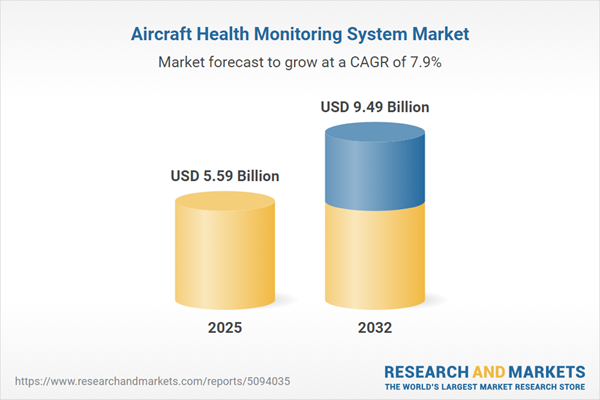Speak directly to the analyst to clarify any post sales queries you may have.
The aircraft health monitoring system market is evolving rapidly as aviation organizations prioritize operational reliability, regulatory compliance, and optimized fleet performance. Leveraging advanced analytics and digital diagnostics, industry stakeholders gain a strategic foundation for informed asset management and risk reduction.
Market Snapshot: Aircraft Health Monitoring System Market Overview
The global aircraft health monitoring system market maintains steady growth, with its value expected to climb from USD 5.18 billion in 2024 to USD 5.59 billion in 2025, reaching USD 9.49 billion by 2032. A robust compound annual growth rate (CAGR) of 7.85% signifies strong demand driven by accelerated adoption of advanced sensor networks, the integration of real-time data analytics, and enhancements in aircraft connectivity. Evolving regulations and the requirement for predictive maintenance are redefining maintenance strategies, prompting decision-makers to update operational processes to align with emerging digital technologies and regulatory standards.
Scope & Segmentation
- Component: Advanced avionics sensors, communication modules, and analytics software work in concert to streamline diagnostics and support proactive maintenance management across diverse fleets.
- Platform Type: Solutions are engineered for both fixed wing and rotary wing applications, suitable for commercial, defense, and executive aviation operations.
- Fit Type: Systems are adaptable for OEM line-fit as well as retrofitting, enabling integration into newly manufactured aircraft and legacy platforms.
- Platform: Implementation ranges from business and general aviation to large-scale commercial airlines and military aviation, delivering scalable solutions for organizations of all sizes.
- Deployment Mode: Operators can choose between onboard and ground-based monitoring, ensuring continuous oversight of aircraft health and timely interventions throughout the asset lifecycle.
- Application: Real-time system diagnostics, predictive analytics, and advanced maintenance planning are central, underpinning operational safety and facilitating compliance with aviation requirements.
- End User: Airlines, maintenance providers, leasing organizations, defense agencies, and MRO firms deploy these solutions to address operational and regulatory complexities specific to their activities and geographies.
- Regional Coverage: North America leads in adopting digital transformation; EMEA emphasizes security and coordinated regulation; Asia-Pacific is experiencing rapid fleet upgrades and expansions fueled by growing demand.
- Key Companies: Key players include General Electric Company, Honeywell International Inc., Raytheon Technologies Corporation, Thales S.A., Safran S.A., Rolls-Royce plc, BAE Systems plc, Airbus SE, The Boeing Company, and Lufthansa Technik AG, each driving innovation and technological progress.
Key Takeaways: Aircraft Health Monitoring System Market
- Artificial intelligence-driven predictive maintenance empowers earlier detection of potential failures, optimizing resource utilization and minimizing operational interruptions.
- Digital twin and Internet of Things (IoT) integrations increase operational transparency, enabling organizations to base maintenance actions on continuous, data-driven insights across enterprise systems.
- Cloud-enabled analytics, supported by blockchain technologies, improve the integrity and efficiency of data sharing, enhancing collaboration and expediting maintenance workflows among multiple stakeholders.
- Operational approaches must adjust to regional variations, reflecting localized digital adoption trends, regulatory landscapes, and modernization rates, which all impact successful strategy execution.
- Partnerships between original equipment manufacturers, technology providers, and services partners are essential to delivering systems that stay current with evolving operational requirements and compliance standards.
Tariff Impact
Recent adjustments to U.S. tariffs have led to an increase in the cost base for importing aircraft health monitoring technologies. Stakeholders are actively addressing these challenges by diversifying supply networks, establishing partnerships in Europe and Asia-Pacific, and scaling domestic production capabilities. These measures enhance access to critical technology and help reduce compliance risks amid ongoing trade fluctuations.
Methodology & Data Sources
This report is informed by structured conversations with manufacturers, technology experts, maintenance operators, and defense sector specialists. Conclusions are validated through regulatory documentation, certification assessments, patent analysis, and comprehensive industry forecasts, offering executives actionable intelligence for high-level planning.
Why This Report Matters
- Supports executive teams in managing complex regulatory, procurement, and operational shifts, increasing resilience across aviation assets.
- Distills actionable trends and regional distinctions, equipping leaders to anticipate risks and address compliance within dynamic market conditions.
- Offers current benchmarks and comparative analytics to inform investments and enhance the competitive strengths of fleets globally.
Conclusion
Aircraft health monitoring systems are fundamental to ensuring aviation safety, operational consistency, and asset integrity. Their integration fosters informed decision-making and drives compliance throughout an increasingly complex industry environment.
Additional Product Information:
- Purchase of this report includes 1 year online access with quarterly updates.
- This report can be updated on request. Please contact our Customer Experience team using the Ask a Question widget on our website.
Table of Contents
3. Executive Summary
4. Market Overview
7. Cumulative Impact of Artificial Intelligence 2025
Companies Mentioned
The companies profiled in this Aircraft Health Monitoring System market report include:- General Electric Company
- Honeywell International Inc.
- Raytheon Technologies Corporation
- Thales S.A.
- Safran S.A.
- Rolls-Royce plc
- BAE Systems plc
- Airbus SE
- The Boeing Company
- Lufthansa Technik AG
Table Information
| Report Attribute | Details |
|---|---|
| No. of Pages | 181 |
| Published | October 2025 |
| Forecast Period | 2025 - 2032 |
| Estimated Market Value ( USD | $ 5.59 Billion |
| Forecasted Market Value ( USD | $ 9.49 Billion |
| Compound Annual Growth Rate | 7.8% |
| Regions Covered | Global |
| No. of Companies Mentioned | 11 |









